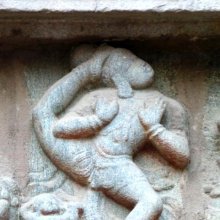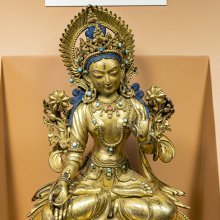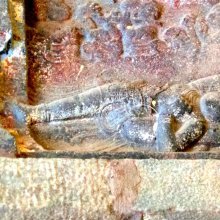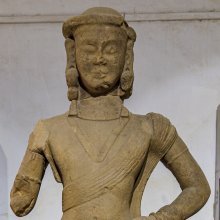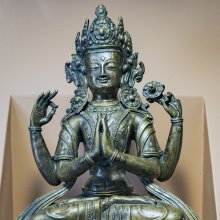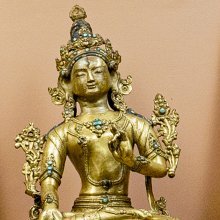Forehead: 4 definitions
Introduction:
Forehead means something in Hinduism, Sanskrit. If you want to know the exact meaning, history, etymology or English translation of this term then check out the descriptions on this page. Add your comment or reference to a book if you want to contribute to this summary article.
Images (photo gallery)
(+15 more images available)
In Hinduism
Yoga (school of philosophy)
Source: ORA: Amanaska (king of all yogas): A Critical Edition and Annotated Translation by Jason BirchForehead (meditation) (i.e., ‘meditating on the forehead and brow’) forms part of the various Teachings or Techniques (saṅketa) on Layayoga, according to the Dattātreyayogaśāstra verse 21-26.—Note: The Dattātreyayogaśāstra’s techniques (saṅketa) of Layayoga can be summarised as meditation on the void, gazing on the tip of the nose, meditating on the back of the head, gazing between the eyebrows, meditating on the forehead and brow, meditating on the two big toes and lying on the ground like a corpse.

Yoga is originally considered a branch of Hindu philosophy (astika), but both ancient and modern Yoga combine the physical, mental and spiritual. Yoga teaches various physical techniques also known as āsanas (postures), used for various purposes (eg., meditation, contemplation, relaxation).
Gitashastra (science of music)
Source: Shodhganga: Elements of Art and Architecture in the Trtiyakhanda of the Visnudharmottarapurana (gita)The Forehead (in Sanskrit: Mūrdha) refers to one of various Organs of Utterance (sthāna), according to Bhattojidīkṣita in his Siddhāntakaumudī.—During the practise of Vocal Music, the proper production of the concerned sound is always considered as very important. Sthāna or ucchāraṇasthāna is the place of articulation of sound. Bhattojidīkṣita in his Siddhāntakaumudī said about ten kinds of sthāna (i.e., the organs of utterance), e.g., mūrdha (forehead).
Gitashastra (गीतशास्त्र, gītaśāstra) refers to the ancient Indian science of Music (gita or samgita), which is traditionally divided in Vocal music, Instrumental music and Dance (under the jurisdiction of music). The different elements and technical terms are explained in a wide range of (often Sanskrit) literature.
Shilpashastra (iconography)
Source: Shodhganga: Elements of Art and Architecture in the Trtiyakhanda of the Visnudharmottarapurana (shilpa)The Forehead is denoted by the Sanskrit term Lalāṭa, and represents one of the various body parts whose Measurements should follow the principles of ancient Indian Painting (citra), according to the Viṣṇudharmottarapurāṇa, an ancient Sanskrit text which (being encyclopedic in nature) deals with a variety of cultural topics such as arts, architecture, music, grammar and astronomy.—In the third part of the Viṣṇudharmottarapurāṇa, chapters 35th to 43rd are dedicated to the Painting of different portraits of different kinds of men and women. The measurement of almost all the body parts that should be maintained in a picture have been presented here. For example, the Forehead (lalāṭa) should be 12 aṅgulas.

Shilpashastra (शिल्पशास्त्र, śilpaśāstra) represents the ancient Indian science (shastra) of creative arts (shilpa) such as sculpture, iconography and painting. Closely related to Vastushastra (architecture), they often share the same literature.
Shaktism (Shakta philosophy)
Source: Google Books: Manthanabhairavatantram1) The Forehead is sometimes associated with Candrābja—one of the Sixteen Siddhas according to the Manthānabhairavatantra, a vast sprawling work that belongs to a corpus of Tantric texts concerned with the worship of the goddess Kubjikā.—These sixteen spiritual teachers represent the disciples of the Nine Nāthas who propagated the Western Transmission noted in the Kubjikā Tantras.—Various texts record the locations of the sixteen Siddhas within the body (called ‘doors’). For example, the Kulakaulinīmata mentions the Forehead, whereas the Ṭīkā mentions the Anus and the Kumārikākhaṇḍa mentions the Uvula as the location of Candrābja.
2) The Forehead is at other times associated with Ṣaṣṭhānanda—another one of the Sixteen Siddhas.—The Kulakaulinīmata mentions the Navel, whereas the Ṭīkā mentions the Forehead (bindusthāna) and the Kumārikākhaṇḍa mentions Blood as the location of Ṣaṣṭhānanda.

Shakta (शाक्त, śākta) or Shaktism (śāktism) represents a tradition of Hinduism where the Goddess (Devi) is revered and worshipped. Shakta literature includes a range of scriptures, including various Agamas and Tantras, although its roots may be traced back to the Vedas.
See also (Relevant definitions)
Partial matches: Forehead, Te.
Query error!
Full-text (+1353): Lalata, Tilaka, Tripundra, Bhala, Visheshaka, Lalamaka, Lalatika, Laka, Lalatapatta, Godhi, Urdhvapundra, Pundra, Bhramaraka, Nitala, Shankhacari, Bhramaralaka, Citraka, Alika, Mahashankha, Lalataka.
Relevant text
Search found 314 books and stories containing Forehead, The forehead; (plurals include: Foreheads, The foreheads). You can also click to the full overview containing English textual excerpts. Below are direct links for the most relevant articles:
Padma Purana (by N.A. Deshpande)
Chapter 225 - The Efficacy of Ūrdhvapuṇḍra < [Section 6 - Uttara-Khaṇḍa (Concluding Section)]
Chapter 53 - Sukalā’s Sickening Description of the Body < [Section 2 - Bhūmi-khaṇḍa (section on the earth)]
Chapter 29 - The Importance of Gopīcandana < [Section 6 - Uttara-Khaṇḍa (Concluding Section)]
Skanda Purana (by G. V. Tagare)
Chapter 2 - The Application of Tripuṇḍra < [Section 5 - Mārgaśīrṣa-māhātmya]
Chapter 16 - Efficacy of the Holy Ash (Continued) < [Section 3 - Brāhmottara-khaṇḍa]
Chapter 37 - The Characteristics of Women < [Section 1 - Pūrvārdha]
Some Guhyas and Ganas < [January – March, 1987]
Naukaa Charitramu-III (Boat story) < [October – December, 1986]
Hara-Gouri < [December 1937]
Chaitanya Bhagavata (by Bhumipati Dāsa)
Verse 1.15.8 < [Chapter 15 - Marriage with Śrī Viṣṇupriyā]
Verse 3.3.206 < [Chapter 3 - Mahāprabhu’s Deliverance of Sarvabhauma, Exhibition of His Six-armed Form, and Journey to Bengal]
Verse 1.4.79 < [Chapter 4 - Name-giving Ceremony, Childhood Pastimes, and Thieves Kidnap the Lord]
Bhakti-rasamrta-sindhu (by Śrīla Rūpa Gosvāmī)
Verse 2.4.71 < [Part 4 - Transient Ecstatic Disturbances (vyābhicāri-bhāva)]
Verse 2.1.354 < [Part 1 - Ecstatic Excitants (vibhāva)]
Verse 2.1.361 < [Part 1 - Ecstatic Excitants (vibhāva)]
Devi Bhagavata Purana (by Swami Vijñanananda)
Related products
